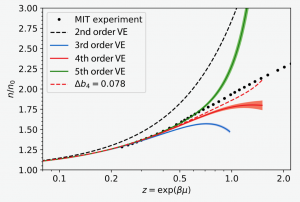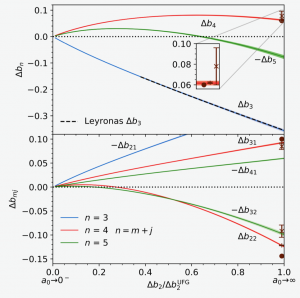The latest work of graduate student Yaqi Hou and associate professor Joaquin Drut just appeared in Physical Review Letters, highlighted as Editor’s suggestion.
Hou and Drut pushed to new heights a non-perturbative computational technique (also originally developed and applied by Drut’s group in a sequence of prior publications, see [1], [2], [3], and [4]) to tackle the high-temperature regime of quantum many-body systems, making it possible to access four- and five-particle quantum correlations in an analytic fashion with controlled uncertainties. Using that approach, based on a systematic approximation and automated algebra methods, they calculated with unprecedented accuracy the fourth- and fifth-order coefficients of the so-called quantum virial expansion of a Fermi gas with strong interactions, connecting the quantum and classical regimes at high temperature. Crucially, Hou and Drut were able to perform extrapolations to account for systematic effects, for the first time. In this work, they focused on the so-called universal regime of three-dimensional Fermi gases, which is of wide interest as it has applications in condensed matter, ultracold atoms and nuclear physics. They have also generalized their results to lower dimensions in another paper.
Notably, while previous calculations had attempted to determine the universal fourth virial coefficient, there remained a large uncertainty and tension between theory and experiment, and no predictions existed at fifth order (nor for any of these in lower-dimensional systems). Hou and Drut shed light on these issues and showed that, as interactions grow, the behavior of the virial coefficients is non-monotonic and results from cancellations between terms that enter with different signs, which also explains why these coefficients are so challenging to calculate with methods that use random numbers. Based on their new results, Hou and Drut were also able to capture multiple thermodynamic quantities, which they compared with experimental data and other theoretical approaches, showing that the virial expansion can capture all of those results beyond the region where it was previously thought to be valid.



